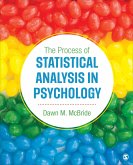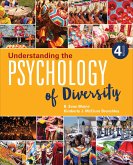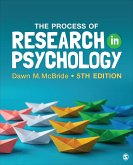Dawn M. McBride (USA Illinois State University)
The Process of Research in Psychology
Dawn M. McBride (USA Illinois State University)
The Process of Research in Psychology
- Broschiertes Buch
- Merkliste
- Auf die Merkliste
- Bewerten Bewerten
- Teilen
- Produkt teilen
- Produkterinnerung
- Produkterinnerung
Employing numerous examples and the pedagogical approach of spaced repetition, this introductory text provides a step-by-step explanation of how to design, conduct, and present research in psychology.
Andere Kunden interessierten sich auch für
![The Process of Research and Statistical Analysis in Psychology The Process of Research and Statistical Analysis in Psychology]() Dawn M. M. McBride (USA Illinois State University)The Process of Research and Statistical Analysis in Psychology143,99 €
Dawn M. M. McBride (USA Illinois State University)The Process of Research and Statistical Analysis in Psychology143,99 €![Scientific Writing for Psychology Scientific Writing for Psychology]() Kail, Robert V., Jr. (USA Purdue University)Scientific Writing for Psychology47,99 €
Kail, Robert V., Jr. (USA Purdue University)Scientific Writing for Psychology47,99 €![The Process of Statistical Analysis in Psychology The Process of Statistical Analysis in Psychology]() Dawn M. McBrideThe Process of Statistical Analysis in Psychology158,99 €
Dawn M. McBrideThe Process of Statistical Analysis in Psychology158,99 €![Understanding the Psychology of Diversity Understanding the Psychology of Diversity]() Bruce E. E. Blaine (USA St. John Fisher College)Understanding the Psychology of Diversity143,99 €
Bruce E. E. Blaine (USA St. John Fisher College)Understanding the Psychology of Diversity143,99 €![The Psychology of Women and Gender The Psychology of Women and Gender]() Nicole M. Else-QuestThe Psychology of Women and Gender168,99 €
Nicole M. Else-QuestThe Psychology of Women and Gender168,99 €![The Process of Research in Psychology The Process of Research in Psychology]() Dawn M. M. McBride (USA Illinois State University)The Process of Research in Psychology135,99 €
Dawn M. M. McBride (USA Illinois State University)The Process of Research in Psychology135,99 €![The Alcoholism and Drug Abuse Client Workbook The Alcoholism and Drug Abuse Client Workbook]() Robert R. PerkinsonThe Alcoholism and Drug Abuse Client Workbook77,99 €
Robert R. PerkinsonThe Alcoholism and Drug Abuse Client Workbook77,99 €-
-
-
Employing numerous examples and the pedagogical approach of spaced repetition, this introductory text provides a step-by-step explanation of how to design, conduct, and present research in psychology.
Hinweis: Dieser Artikel kann nur an eine deutsche Lieferadresse ausgeliefert werden.
Hinweis: Dieser Artikel kann nur an eine deutsche Lieferadresse ausgeliefert werden.
Produktdetails
- Produktdetails
- Verlag: SAGE Publications Inc
- 4 Revised edition
- Seitenzahl: 424
- Erscheinungstermin: 16. Januar 2019
- Englisch
- Abmessung: 232mm x 190mm x 17mm
- Gewicht: 640g
- ISBN-13: 9781544323497
- ISBN-10: 1544323492
- Artikelnr.: 53485413
- Herstellerkennzeichnung Die Herstellerinformationen sind derzeit nicht verfügbar.
- Verlag: SAGE Publications Inc
- 4 Revised edition
- Seitenzahl: 424
- Erscheinungstermin: 16. Januar 2019
- Englisch
- Abmessung: 232mm x 190mm x 17mm
- Gewicht: 640g
- ISBN-13: 9781544323497
- ISBN-10: 1544323492
- Artikelnr.: 53485413
- Herstellerkennzeichnung Die Herstellerinformationen sind derzeit nicht verfügbar.
Dawn M. McBride is a professor of psychology at Illinois State University, where she has taught research methods since 1998. Her research interests include automatic forms of memory, false memory, prospective memory, task order choices, and forgetting. In addition to research methods, she teaches courses in introductory psychology, cognition and learning, and human memory, and a graduate course in experimental design. She is a recipient of the Illinois State University Teaching Initiative Award and the Illinois State University SPA/Psi Chi Jim Johnson Award for commitment to undergraduate mentorship, involvement, and achievement. Her nonacademic interests include spending time with her family, traveling, watching Philadelphia sports teams (it was a good year for Philly sports this year!), and reading British murder mysteries. She earned her PhD in cognitive psychology from the University of California, Irvine, and her BA from the University of California, Los Angeles.
Preface
Acknowledgments
About the Author
PART I. OVERVIEW OF THE RESEARCH PROCESS FROM START TO FINISH
Chapter 1. Psychological Research: The Whys and Hows of the Scientific Method
Why Should I Care About Research if I Don¿t Want to Do Research in My Career?
Why Psychologists Conduct Research
How Psychologists Use the Scientific Method
Basic and Applied Research
Chapter Summary
Common Pitfalls and How to Avoid Them
Applying Your Knowledge
Test Yourself
Stop and Think Answers
Chapter 2. Hypothesis Development: Where Research Questions Come From
Developing a Research Question
How to Conduct a Literature Review
What You Find in a Literature Review
Using the Literature to Make Hypotheses
Chapter Summary
Common Pitfalls and How to Avoid Them
Applying Your Knowledge
Test Yourself
Stop and Think Answers
Chapter 3. Ethical Guidelines for Psychological Research
Historical Context for Ethical Guidelines
Current Ethical Guidelines for Human Participants Research
Institutional Review Boards
Current Ethical Guidelines for Nonhuman Animal Subjects
Ethics in Reporting Research
Chapter Summary
Common Pitfalls and How to Avoid Them
Applying Your Knowledge
Test Yourself
Stop and Think Answers
Chapter 4. How Psychologists Use the Scientific Method: Data Collection Techniques and Research Designs
Data Collection Techniques
Types of Research Designs
Chapter Summary
Common Pitfalls and How to Avoid Them
Applying Your Knowledge
Test Yourself
Stop and Think Answers
Chapter 5. Variables and Measurement in Research
Dependent Variables
Independent Variables
Validity and Sources of Bias
Chapter Summary
Common Pitfalls and How to Avoid Them
Applying Your Knowledge
Test Yourself
Stop and Think Answers
Chapter 6. Sampling
Populations and Samples
Probability Samples
Convenience Samples
Comparison of Probability and Convenience Sampling Techniques
Recruiting Participants
Using the Internet to Sample
Chapter Summary
Common Pitfalls and How to Avoid Them
Applying Your Knowledge
Test Yourself
Stop and Think Answers
Chapter 7. Summarizing and Interpreting Data: Using Statistics
Descriptive Statistics: Summarizing the Data
Inferential Statistics: Testing Hypotheses
Predicting the Null Hypothesis
Chapter Summary
Common Pitfalls and How to Avoid Them
Applying Your Knowledge
Test Yourself
Stop and Think Answers
Chapter 8. Reporting Research
APA-Style Article Writing
Oral Presentations
Poster Presentations
Chapter Summary
Common Pitfalls and How to Avoid Them
Applying Your Knowledge
Test Yourself
Stop and Think Answers
PART II. MORE ABOUT RESEARCH METHODS AND ANALYSIS
Chapter 9. More About Using Statistics
Comparing Groups or Conditions
Chapter Summary
Common Pitfalls and How to Avoid Them
Applying Your Knowledge
Test Yourself
Stop and Think Answers
Chapter 10. More About Survey Research
Answering Research Questions With Surveys
Creating a Survey
Survey Administration
Chapter Summary
Common Pitfalls and How to Avoid Them
Applying Your Knowledge
Test Yourself
Stop and Think Answers
Chapter 11. More About Correlational Studies
Research Questions in Correlational Studies
Correlational Study Examples
Chapter Summary
Common Pitfalls and How to Avoid Them
Applying Your Knowledge
Test Yourself
Stop and Think Answers
Chapter 12. More About One-Factor Experiments
Learning About Causation Through Manipulation and Control
Control in Within-Subjects and Between-Subjects Experiments
Experiment Examples
Chapter Summary
Common Pitfalls and How to Avoid Them
Applying Your Knowledge
Test Yourself
Stop and Think Answers
Chapter 13. More About Multi-Factor Experiments
Factorial Designs
More About Interactions
Experiment Examples
Chapter Summary
Common Pitfalls and How to Avoid Them
Applying Your Knowledge
Test Yourself
Stop and Think Answers
Chapter 14. More About Quasi-Experiments
Types of Quasi-Experiments
Sources of Bias in Quasi-Experiments
Chapter Summary
Common Pitfalls and How to Avoid Them
Applying Your Knowledge
Test Yourself
Stop and Think Answers
Chapter 15. More About Other Specialized Designs
Developmental Designs
Small-n Designs
Chapter Summary
Common Pitfalls and How to Avoid Them
Applying Your Knowledge
Test Yourself
Stop and Think Answers
Appendix: Statistical Calculations
Glossary
References
Index
Acknowledgments
About the Author
PART I. OVERVIEW OF THE RESEARCH PROCESS FROM START TO FINISH
Chapter 1. Psychological Research: The Whys and Hows of the Scientific Method
Why Should I Care About Research if I Don¿t Want to Do Research in My Career?
Why Psychologists Conduct Research
How Psychologists Use the Scientific Method
Basic and Applied Research
Chapter Summary
Common Pitfalls and How to Avoid Them
Applying Your Knowledge
Test Yourself
Stop and Think Answers
Chapter 2. Hypothesis Development: Where Research Questions Come From
Developing a Research Question
How to Conduct a Literature Review
What You Find in a Literature Review
Using the Literature to Make Hypotheses
Chapter Summary
Common Pitfalls and How to Avoid Them
Applying Your Knowledge
Test Yourself
Stop and Think Answers
Chapter 3. Ethical Guidelines for Psychological Research
Historical Context for Ethical Guidelines
Current Ethical Guidelines for Human Participants Research
Institutional Review Boards
Current Ethical Guidelines for Nonhuman Animal Subjects
Ethics in Reporting Research
Chapter Summary
Common Pitfalls and How to Avoid Them
Applying Your Knowledge
Test Yourself
Stop and Think Answers
Chapter 4. How Psychologists Use the Scientific Method: Data Collection Techniques and Research Designs
Data Collection Techniques
Types of Research Designs
Chapter Summary
Common Pitfalls and How to Avoid Them
Applying Your Knowledge
Test Yourself
Stop and Think Answers
Chapter 5. Variables and Measurement in Research
Dependent Variables
Independent Variables
Validity and Sources of Bias
Chapter Summary
Common Pitfalls and How to Avoid Them
Applying Your Knowledge
Test Yourself
Stop and Think Answers
Chapter 6. Sampling
Populations and Samples
Probability Samples
Convenience Samples
Comparison of Probability and Convenience Sampling Techniques
Recruiting Participants
Using the Internet to Sample
Chapter Summary
Common Pitfalls and How to Avoid Them
Applying Your Knowledge
Test Yourself
Stop and Think Answers
Chapter 7. Summarizing and Interpreting Data: Using Statistics
Descriptive Statistics: Summarizing the Data
Inferential Statistics: Testing Hypotheses
Predicting the Null Hypothesis
Chapter Summary
Common Pitfalls and How to Avoid Them
Applying Your Knowledge
Test Yourself
Stop and Think Answers
Chapter 8. Reporting Research
APA-Style Article Writing
Oral Presentations
Poster Presentations
Chapter Summary
Common Pitfalls and How to Avoid Them
Applying Your Knowledge
Test Yourself
Stop and Think Answers
PART II. MORE ABOUT RESEARCH METHODS AND ANALYSIS
Chapter 9. More About Using Statistics
Comparing Groups or Conditions
Chapter Summary
Common Pitfalls and How to Avoid Them
Applying Your Knowledge
Test Yourself
Stop and Think Answers
Chapter 10. More About Survey Research
Answering Research Questions With Surveys
Creating a Survey
Survey Administration
Chapter Summary
Common Pitfalls and How to Avoid Them
Applying Your Knowledge
Test Yourself
Stop and Think Answers
Chapter 11. More About Correlational Studies
Research Questions in Correlational Studies
Correlational Study Examples
Chapter Summary
Common Pitfalls and How to Avoid Them
Applying Your Knowledge
Test Yourself
Stop and Think Answers
Chapter 12. More About One-Factor Experiments
Learning About Causation Through Manipulation and Control
Control in Within-Subjects and Between-Subjects Experiments
Experiment Examples
Chapter Summary
Common Pitfalls and How to Avoid Them
Applying Your Knowledge
Test Yourself
Stop and Think Answers
Chapter 13. More About Multi-Factor Experiments
Factorial Designs
More About Interactions
Experiment Examples
Chapter Summary
Common Pitfalls and How to Avoid Them
Applying Your Knowledge
Test Yourself
Stop and Think Answers
Chapter 14. More About Quasi-Experiments
Types of Quasi-Experiments
Sources of Bias in Quasi-Experiments
Chapter Summary
Common Pitfalls and How to Avoid Them
Applying Your Knowledge
Test Yourself
Stop and Think Answers
Chapter 15. More About Other Specialized Designs
Developmental Designs
Small-n Designs
Chapter Summary
Common Pitfalls and How to Avoid Them
Applying Your Knowledge
Test Yourself
Stop and Think Answers
Appendix: Statistical Calculations
Glossary
References
Index
Preface
Acknowledgments
About the Author
PART I. OVERVIEW OF THE RESEARCH PROCESS FROM START TO FINISH
Chapter 1. Psychological Research: The Whys and Hows of the Scientific Method
Why Should I Care About Research if I Don¿t Want to Do Research in My Career?
Why Psychologists Conduct Research
How Psychologists Use the Scientific Method
Basic and Applied Research
Chapter Summary
Common Pitfalls and How to Avoid Them
Applying Your Knowledge
Test Yourself
Stop and Think Answers
Chapter 2. Hypothesis Development: Where Research Questions Come From
Developing a Research Question
How to Conduct a Literature Review
What You Find in a Literature Review
Using the Literature to Make Hypotheses
Chapter Summary
Common Pitfalls and How to Avoid Them
Applying Your Knowledge
Test Yourself
Stop and Think Answers
Chapter 3. Ethical Guidelines for Psychological Research
Historical Context for Ethical Guidelines
Current Ethical Guidelines for Human Participants Research
Institutional Review Boards
Current Ethical Guidelines for Nonhuman Animal Subjects
Ethics in Reporting Research
Chapter Summary
Common Pitfalls and How to Avoid Them
Applying Your Knowledge
Test Yourself
Stop and Think Answers
Chapter 4. How Psychologists Use the Scientific Method: Data Collection Techniques and Research Designs
Data Collection Techniques
Types of Research Designs
Chapter Summary
Common Pitfalls and How to Avoid Them
Applying Your Knowledge
Test Yourself
Stop and Think Answers
Chapter 5. Variables and Measurement in Research
Dependent Variables
Independent Variables
Validity and Sources of Bias
Chapter Summary
Common Pitfalls and How to Avoid Them
Applying Your Knowledge
Test Yourself
Stop and Think Answers
Chapter 6. Sampling
Populations and Samples
Probability Samples
Convenience Samples
Comparison of Probability and Convenience Sampling Techniques
Recruiting Participants
Using the Internet to Sample
Chapter Summary
Common Pitfalls and How to Avoid Them
Applying Your Knowledge
Test Yourself
Stop and Think Answers
Chapter 7. Summarizing and Interpreting Data: Using Statistics
Descriptive Statistics: Summarizing the Data
Inferential Statistics: Testing Hypotheses
Predicting the Null Hypothesis
Chapter Summary
Common Pitfalls and How to Avoid Them
Applying Your Knowledge
Test Yourself
Stop and Think Answers
Chapter 8. Reporting Research
APA-Style Article Writing
Oral Presentations
Poster Presentations
Chapter Summary
Common Pitfalls and How to Avoid Them
Applying Your Knowledge
Test Yourself
Stop and Think Answers
PART II. MORE ABOUT RESEARCH METHODS AND ANALYSIS
Chapter 9. More About Using Statistics
Comparing Groups or Conditions
Chapter Summary
Common Pitfalls and How to Avoid Them
Applying Your Knowledge
Test Yourself
Stop and Think Answers
Chapter 10. More About Survey Research
Answering Research Questions With Surveys
Creating a Survey
Survey Administration
Chapter Summary
Common Pitfalls and How to Avoid Them
Applying Your Knowledge
Test Yourself
Stop and Think Answers
Chapter 11. More About Correlational Studies
Research Questions in Correlational Studies
Correlational Study Examples
Chapter Summary
Common Pitfalls and How to Avoid Them
Applying Your Knowledge
Test Yourself
Stop and Think Answers
Chapter 12. More About One-Factor Experiments
Learning About Causation Through Manipulation and Control
Control in Within-Subjects and Between-Subjects Experiments
Experiment Examples
Chapter Summary
Common Pitfalls and How to Avoid Them
Applying Your Knowledge
Test Yourself
Stop and Think Answers
Chapter 13. More About Multi-Factor Experiments
Factorial Designs
More About Interactions
Experiment Examples
Chapter Summary
Common Pitfalls and How to Avoid Them
Applying Your Knowledge
Test Yourself
Stop and Think Answers
Chapter 14. More About Quasi-Experiments
Types of Quasi-Experiments
Sources of Bias in Quasi-Experiments
Chapter Summary
Common Pitfalls and How to Avoid Them
Applying Your Knowledge
Test Yourself
Stop and Think Answers
Chapter 15. More About Other Specialized Designs
Developmental Designs
Small-n Designs
Chapter Summary
Common Pitfalls and How to Avoid Them
Applying Your Knowledge
Test Yourself
Stop and Think Answers
Appendix: Statistical Calculations
Glossary
References
Index
Acknowledgments
About the Author
PART I. OVERVIEW OF THE RESEARCH PROCESS FROM START TO FINISH
Chapter 1. Psychological Research: The Whys and Hows of the Scientific Method
Why Should I Care About Research if I Don¿t Want to Do Research in My Career?
Why Psychologists Conduct Research
How Psychologists Use the Scientific Method
Basic and Applied Research
Chapter Summary
Common Pitfalls and How to Avoid Them
Applying Your Knowledge
Test Yourself
Stop and Think Answers
Chapter 2. Hypothesis Development: Where Research Questions Come From
Developing a Research Question
How to Conduct a Literature Review
What You Find in a Literature Review
Using the Literature to Make Hypotheses
Chapter Summary
Common Pitfalls and How to Avoid Them
Applying Your Knowledge
Test Yourself
Stop and Think Answers
Chapter 3. Ethical Guidelines for Psychological Research
Historical Context for Ethical Guidelines
Current Ethical Guidelines for Human Participants Research
Institutional Review Boards
Current Ethical Guidelines for Nonhuman Animal Subjects
Ethics in Reporting Research
Chapter Summary
Common Pitfalls and How to Avoid Them
Applying Your Knowledge
Test Yourself
Stop and Think Answers
Chapter 4. How Psychologists Use the Scientific Method: Data Collection Techniques and Research Designs
Data Collection Techniques
Types of Research Designs
Chapter Summary
Common Pitfalls and How to Avoid Them
Applying Your Knowledge
Test Yourself
Stop and Think Answers
Chapter 5. Variables and Measurement in Research
Dependent Variables
Independent Variables
Validity and Sources of Bias
Chapter Summary
Common Pitfalls and How to Avoid Them
Applying Your Knowledge
Test Yourself
Stop and Think Answers
Chapter 6. Sampling
Populations and Samples
Probability Samples
Convenience Samples
Comparison of Probability and Convenience Sampling Techniques
Recruiting Participants
Using the Internet to Sample
Chapter Summary
Common Pitfalls and How to Avoid Them
Applying Your Knowledge
Test Yourself
Stop and Think Answers
Chapter 7. Summarizing and Interpreting Data: Using Statistics
Descriptive Statistics: Summarizing the Data
Inferential Statistics: Testing Hypotheses
Predicting the Null Hypothesis
Chapter Summary
Common Pitfalls and How to Avoid Them
Applying Your Knowledge
Test Yourself
Stop and Think Answers
Chapter 8. Reporting Research
APA-Style Article Writing
Oral Presentations
Poster Presentations
Chapter Summary
Common Pitfalls and How to Avoid Them
Applying Your Knowledge
Test Yourself
Stop and Think Answers
PART II. MORE ABOUT RESEARCH METHODS AND ANALYSIS
Chapter 9. More About Using Statistics
Comparing Groups or Conditions
Chapter Summary
Common Pitfalls and How to Avoid Them
Applying Your Knowledge
Test Yourself
Stop and Think Answers
Chapter 10. More About Survey Research
Answering Research Questions With Surveys
Creating a Survey
Survey Administration
Chapter Summary
Common Pitfalls and How to Avoid Them
Applying Your Knowledge
Test Yourself
Stop and Think Answers
Chapter 11. More About Correlational Studies
Research Questions in Correlational Studies
Correlational Study Examples
Chapter Summary
Common Pitfalls and How to Avoid Them
Applying Your Knowledge
Test Yourself
Stop and Think Answers
Chapter 12. More About One-Factor Experiments
Learning About Causation Through Manipulation and Control
Control in Within-Subjects and Between-Subjects Experiments
Experiment Examples
Chapter Summary
Common Pitfalls and How to Avoid Them
Applying Your Knowledge
Test Yourself
Stop and Think Answers
Chapter 13. More About Multi-Factor Experiments
Factorial Designs
More About Interactions
Experiment Examples
Chapter Summary
Common Pitfalls and How to Avoid Them
Applying Your Knowledge
Test Yourself
Stop and Think Answers
Chapter 14. More About Quasi-Experiments
Types of Quasi-Experiments
Sources of Bias in Quasi-Experiments
Chapter Summary
Common Pitfalls and How to Avoid Them
Applying Your Knowledge
Test Yourself
Stop and Think Answers
Chapter 15. More About Other Specialized Designs
Developmental Designs
Small-n Designs
Chapter Summary
Common Pitfalls and How to Avoid Them
Applying Your Knowledge
Test Yourself
Stop and Think Answers
Appendix: Statistical Calculations
Glossary
References
Index








